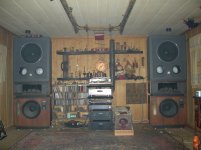I am wanting to try a different type of bass from my current Onkens for my Altec 414z's. I have looked around the web and there doesn't seem to be that many options suitable for these drivers. I don't want to build a front loaded horn, as i don't have the space, and would like to go to at least 40hz.
I fancied MLTL but discussions on quarterwave suggested the driver isn't suitable. What options are there for these drivers, i experimented with an altec 604 cabinet, but did not get the bass to sound right, sounded like a bad BR alignment.
I fancied MLTL but discussions on quarterwave suggested the driver isn't suitable. What options are there for these drivers, i experimented with an altec 604 cabinet, but did not get the bass to sound right, sounded like a bad BR alignment.
GM, a member here, would be helpful in this regard. See if you can get a response. I am not at home, so I can't modl anything, but I have in the past and got good results.
Try GR box of 16x24x39, with driver 7" down and port 38" down. Start with 4 radius and 6" length. This assumes converting port to slot.
Try GR box of 16x24x39, with driver 7" down and port 38" down. Start with 4 radius and 6" length. This assumes converting port to slot.
Looking back - it was the TQWT that modelled up poorly.
Reading about MLTL they are bass shy compared with other types, probably cleaner through, i am looking for good LF to keep up with the rest of the setup.
The altec only needs to go upto around 350Hz, where my midbass horn takes over, it will also be active.
Did see this http://www.diyaudio.com/forums/attachments/multi-way/308352d1351207874-horn-tl-combo-dsc05358.jpg which as an idea could work for me, makes the time alignment easier, front horn/MTLT?? Will also integrate better with the other horns.
Also saw this, which i like ABSOLUTE AUDIO & VISUAL - Jadis OLYMPIA. Claims to go to 110Hz with the WG and the onken below that.
Reading about MLTL they are bass shy compared with other types, probably cleaner through, i am looking for good LF to keep up with the rest of the setup.
The altec only needs to go upto around 350Hz, where my midbass horn takes over, it will also be active.
Did see this http://www.diyaudio.com/forums/attachments/multi-way/308352d1351207874-horn-tl-combo-dsc05358.jpg which as an idea could work for me, makes the time alignment easier, front horn/MTLT?? Will also integrate better with the other horns.
Also saw this, which i like ABSOLUTE AUDIO & VISUAL - Jadis OLYMPIA. Claims to go to 110Hz with the WG and the onken below that.
Horns will have good midbass, but will be more likely bass shy in lower octaves. First design is very tempting, combining horn and Onken qualities, but unsure of its performance. I don't think the large mltl will be bass shy, being limited mostly by the cone area more than anything.
I agree that combining a front horn with something else to reinforce the bottom end is an idea i like. You can with the Onken get a peak around 70Hz which gives you a slightly lower F3, maybe the front horn could equilise the response by bringing the midbass up in SPL. Blue thunder is a good example of this, what worries me is what happens below mouth freq response, as with all other horns you cut them within 1.6XFc. What interested me in the Jardis example was how the assysmetric is being used, is this for ground plane effects or just to get a larger mouth
Big depends on your perspective!!
My current set up is not exactly small.

A can have a large volume cabinet if it is tall. Give me something to attach the rest of the horns to. As far as i am aware its either a TQWT or something like this http://ts1.mm.bing.net/th?id=H.4706159725839784&pid=15.1 which looks like a horn firing into the floor, which meets this requirement.
Positioning of the drivers is also important, want to get them as close together as possible. The limiting feature will be the Beyma TPL which needs to be a "seated ear height", so was going to position everything else around it
My current set up is not exactly small.

A can have a large volume cabinet if it is tall. Give me something to attach the rest of the horns to. As far as i am aware its either a TQWT or something like this http://ts1.mm.bing.net/th?id=H.4706159725839784&pid=15.1 which looks like a horn firing into the floor, which meets this requirement.
Positioning of the drivers is also important, want to get them as close together as possible. The limiting feature will be the Beyma TPL which needs to be a "seated ear height", so was going to position everything else around it
Here two links for your type of drivers, Altec 414 (what are the z's?). Do you have the T/S parameters or reference?
http://www.greatplainsaudio.com/vintage_altec/9849-8B_studiomonitor_spec_sheet.pdf
http://www.greatplainsaudio.com/vintage_altec/844A_studiomonitor_spec_sheet.pdf
more here: http://www.greatplainsaudio.com/vintage_altec/
http://www.greatplainsaudio.com/vintage_altec/9849-8B_studiomonitor_spec_sheet.pdf
http://www.greatplainsaudio.com/vintage_altec/844A_studiomonitor_spec_sheet.pdf
more here: http://www.greatplainsaudio.com/vintage_altec/
Have been sketching a couple of cabinet options out, Looks if i build a tall cabinet to support the horns i can get around 260 ltrs (~10 ft3) Making the cabinet around 160mm 5'4' tall with a stepped front to accomodate the Beyma TPL and horn. Adding a front loaded horn would reduce this volume by around 90 ltrs (3 ft3). (My hope is some directionality to the lower midbass that a horn would give, may minimise the room interactions)
Cannot find a simulator that will allow me to model a really large cabinet to understand if the trade between a 10 ft3 cabinet and a 7 ft3 one is worthwhile from LF response, is bigger always better?
The columnal shape of the cabinet worries me with a BR (onken etc), but might suit a TL. (no experinence to justify this concern though)
Measured a driver, higher Fs than i remember, maybe i need to get the Altecs recharged and the suspensions cleaned to restore the FS. Have seen the Danish guy who claims that removing and redoping the suspension is worthwhile, anybody else got any experiences on this ? Is it something i do myself or get the pro-shop to do when they recharge the alnicos?
Cannot find a simulator that will allow me to model a really large cabinet to understand if the trade between a 10 ft3 cabinet and a 7 ft3 one is worthwhile from LF response, is bigger always better?
The columnal shape of the cabinet worries me with a BR (onken etc), but might suit a TL. (no experinence to justify this concern though)
Measured a driver, higher Fs than i remember, maybe i need to get the Altecs recharged and the suspensions cleaned to restore the FS. Have seen the Danish guy who claims that removing and redoping the suspension is worthwhile, anybody else got any experiences on this ? Is it something i do myself or get the pro-shop to do when they recharge the alnicos?
They are suitable for most any style cab, it just depends on how much EQ is available/acceptable. This is the beauty of an efficient driver, plenty of tuning flexibility, so ‘BIB’ can be worthwhile and all else equal, less net cab volume [Vb] means less LF gain BW, so typically it’s the room’s acoustics and where the speakers are located combined with the desired tuning that will determine the ~optimum net Vb.
Few folks will measure the room’s response though, so my default recommendation is to build the largest cab practical since it will allow the most tuning flexibility.
Hmm, to have directivity control down into the lower mid-bass [80-120 Hz] requires a cinema size ‘bass’ horn if not built into a corner and even then much larger than ~90 L, so do you mean lower mids same as the A7, etc. series? This requires a large, wide BW woofer system to keep up.
Acoustically, there is no such thing as a high aspect ratio [column, tower] BR since this assumes the trapped air in the cab has a ~uniform particle density. Instead, it morphs into a closed pipe [¼ WL TL] with tuning dependent on the driver and vent location along its acoustic path-length, though if the vent is near the driver like a BR, then it will perform like a poorly tuned BR due to the various ¼ and ½ WL pipe action modulating the driver, vent output.
Get it right though and the vent loaded TL [MLTL] will perform better overall than any typical BR, including the Onken, due to its superior vent damping.
The inverse tapered TQWT is best suited for drivers that require a long vent for optimum performance.
This and much more is explained in great detail in MJK’s docs and can be simmed with his software and some others to a greater or lesser extent.
Altec driver Fs varied over the decades, ditto factory tolerance by the early ‘70s, so unless you know what the original Fs was, then no way to know if doing the messy, smelly cleaning, resealing of the suspension will be worth it unless it’s obvious that the goop has a lot of hair or other debris to hinder its flexibility.
At the very least though, heating the surround up with a heat gun and using a stiff bristle glue applicator to remove any that puddles at the bottom is normally worth the effort. Even then, if they are in a relatively warm room it’s best to rotate them periodically to offset any obvious additional puddling that may allow pinholes to develop at the top of the surround, ultimately audibly raising cab tuning, maybe even enough to cause damaging excursion if there’s significant signal output below it.
FYI, draining, recharging the magnets should have no impact on driver Fs, only on BL, Qes, Qts.
So, what is the max height [without any tapering], width, depth that can be tolerated?
GM
Few folks will measure the room’s response though, so my default recommendation is to build the largest cab practical since it will allow the most tuning flexibility.
Hmm, to have directivity control down into the lower mid-bass [80-120 Hz] requires a cinema size ‘bass’ horn if not built into a corner and even then much larger than ~90 L, so do you mean lower mids same as the A7, etc. series? This requires a large, wide BW woofer system to keep up.
Acoustically, there is no such thing as a high aspect ratio [column, tower] BR since this assumes the trapped air in the cab has a ~uniform particle density. Instead, it morphs into a closed pipe [¼ WL TL] with tuning dependent on the driver and vent location along its acoustic path-length, though if the vent is near the driver like a BR, then it will perform like a poorly tuned BR due to the various ¼ and ½ WL pipe action modulating the driver, vent output.
Get it right though and the vent loaded TL [MLTL] will perform better overall than any typical BR, including the Onken, due to its superior vent damping.
The inverse tapered TQWT is best suited for drivers that require a long vent for optimum performance.
This and much more is explained in great detail in MJK’s docs and can be simmed with his software and some others to a greater or lesser extent.
Altec driver Fs varied over the decades, ditto factory tolerance by the early ‘70s, so unless you know what the original Fs was, then no way to know if doing the messy, smelly cleaning, resealing of the suspension will be worth it unless it’s obvious that the goop has a lot of hair or other debris to hinder its flexibility.
At the very least though, heating the surround up with a heat gun and using a stiff bristle glue applicator to remove any that puddles at the bottom is normally worth the effort. Even then, if they are in a relatively warm room it’s best to rotate them periodically to offset any obvious additional puddling that may allow pinholes to develop at the top of the surround, ultimately audibly raising cab tuning, maybe even enough to cause damaging excursion if there’s significant signal output below it.
FYI, draining, recharging the magnets should have no impact on driver Fs, only on BL, Qes, Qts.
So, what is the max height [without any tapering], width, depth that can be tolerated?
GM
Thanks for your detailed response GM.
I understand the essence of what your saying in the first paragraph, i don't understand how i will account for the room acoustic, is this an AOT senario? Attached is a FR trace of the altecs in the onkens, measured from my listening position ~9ft away. As uou can see i have a minor peak around 90 hz.
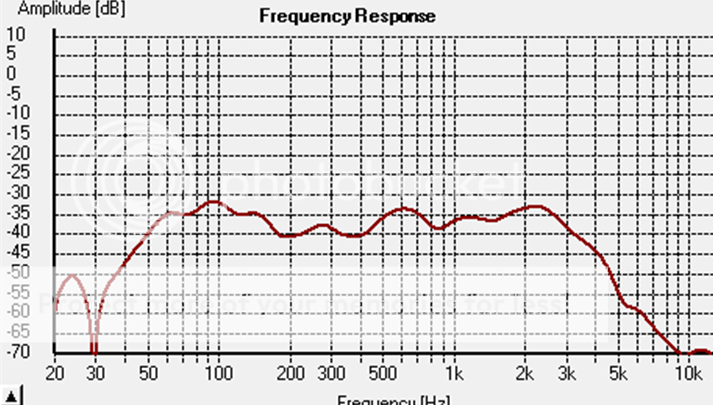 Whether this is poor tuning of the onken or room interaction i cannot decide. They do sit into a corner, but its interupted by windows on both sides.
Whether this is poor tuning of the onken or room interaction i cannot decide. They do sit into a corner, but its interupted by windows on both sides.
With respect to the front horns, the Jardis Olympia reference i posted claims around 120Hz, from what i think is a reasonable sized. My logic was if this 90Hz hump is room then mybe i can EQ it with a horn. (BW? -back wave?) Also setting driver back in horn will help with time alignment.
You basically recommend a MLTL, as the best approach, my ignorance of this cabinet type means i cannot comment, although i throught it was a column with a CSA proportional to sd, so am unclear how to make internal volume bigger with these constraints.
I tried my wifes hair drier a while back without any joy, was nervous about using anything hotter. There is some chipboard particles attached on the inside with abit of hair that i would like to remove, as i know that the surrounds could rip if its too stiff in places.
Max Size of cabinet where it is flat sided is 24" wide x 24" deep x 32" tall (so Beyma's at correct height)
I understand the essence of what your saying in the first paragraph, i don't understand how i will account for the room acoustic, is this an AOT senario? Attached is a FR trace of the altecs in the onkens, measured from my listening position ~9ft away. As uou can see i have a minor peak around 90 hz.

With respect to the front horns, the Jardis Olympia reference i posted claims around 120Hz, from what i think is a reasonable sized. My logic was if this 90Hz hump is room then mybe i can EQ it with a horn. (BW? -back wave?) Also setting driver back in horn will help with time alignment.
You basically recommend a MLTL, as the best approach, my ignorance of this cabinet type means i cannot comment, although i throught it was a column with a CSA proportional to sd, so am unclear how to make internal volume bigger with these constraints.
I tried my wifes hair drier a while back without any joy, was nervous about using anything hotter. There is some chipboard particles attached on the inside with abit of hair that i would like to remove, as i know that the surrounds could rip if its too stiff in places.
Max Size of cabinet where it is flat sided is 24" wide x 24" deep x 32" tall (so Beyma's at correct height)
I built large bass horns for GOTO, using the 416 as a model. You could place the cabinets on the side or upright. CNC approach made for an easier build. See Stereophile link here -
Capital AudioFest 2011 | Stereophile.com
Ming Su (US GOTO rep) demo'd these at Rocky Mtn. The design mirrors the Jensen Imperial, which I've re-created in a modern version drawing in 3D, see attached.
Have you considered an A5/7 VOTT?
Cheers.
Andrew.
Capital AudioFest 2011 | Stereophile.com
Ming Su (US GOTO rep) demo'd these at Rocky Mtn. The design mirrors the Jensen Imperial, which I've re-created in a modern version drawing in 3D, see attached.
Have you considered an A5/7 VOTT?
Cheers.
Andrew.
Attachments
Thanks for your detailed response GM.
i don't understand how i will account for the room acoustic, is this an AOT senario?
As uou can see i have a minor peak around 90 hz.
Whether this is poor tuning of the onken or room interaction i cannot decide.
You basically recommend a MLTL, as the best approach, my ignorance of this cabinet type means i cannot comment, although i throught it was a column with a CSA proportional to sd, so am unclear how to make internal volume bigger with these constraints.
I tried my wifes hair drier a while back without any joy, was nervous about using anything hotter. There is some chipboard particles attached on the inside with abit of hair that i would like to remove, as i know that the surrounds could rip if its too stiff in places.
Max Size of cabinet where it is flat sided is 24" wide x 24" deep x 32" tall (so Beyma's at correct height)
You’re welcome!
AOT? I thought I knew them all………
Probably a room mode combined with the speaker’s output.
BW = band-width
Well, the MLTL is a simple to design/build/tweak, higher sound quality [SQ] vented alignment, so hard to go wrong with it IF it meets the needs of the app.
No, its net Vb has nothing to do with its Sd, nor is it proportional to it. MJK just chose to use it to define CSA for his own reasons and to make CSA larger, just increase the multipler and of course you can increase the length. Personally, I change the worksheets to input a net Vb, then CSA is found by dividing by its length [L].
Hmm, my mid ‘50s era 515Bs are currently in a ~45 degF room and I had no problem softening one of them up enough to brush/remove some excess after only a minute or two using an old, inexpensive 1600W 125 V/60 Hz ‘Salon’ hair dryer, so maybe yours have reached the point that they need to be chemically restored.
Anyway, ~32” isn’t long enough to have much TL action, so the cab will need to be folded in half in an inverted ‘U’ with a vertical divider to get a ~61” path-length assuming ¾” [19 mm] void free plywood with the driver at the top front and the vent at the back bottom side or rear.
Using some averaged measured specs, there’s sufficient length, net Vb to tune all the way down to around 32 Hz or up to an Onken-like ~45 Hz max flat alignment depending on the vent area, so should be reasonably tolerant of driver specs even if driven with a high output impedance.
Sims are minimally damped, so plenty of flexibility if there’s any in room ‘boom’ due to the 4th order roll off.
~32 Hz Fb with a 5” diameter x ¾” long vent
~45 Hz Fb with a 10” diameter x ¾” long vent
GM
Attachments
Altec model 19 with 18" sub ( :
Here is a picture of my old friends stereo.Suddenly I am jealous. If your willing to mount like that, I have a great idea I wasn't able to get by wife. I am back home now. Will post drawing and results.
Attachments
- Status
- This old topic is closed. If you want to reopen this topic, contact a moderator using the "Report Post" button.
- Home
- Loudspeakers
- Multi-Way
- Cabinet Design for Altec 414z's
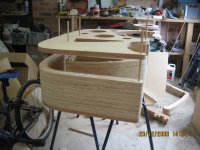
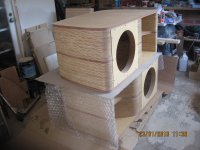
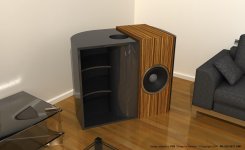
![Altec 414Z 32 Hz MLTL [vinylnvalves].gif](/community/data/attachments/286/286379-cd873be2d97899d6cc8dc7f40745dbd9.jpg)
![Altec 414Z max flat MLTL [vinylnvalves].gif](/community/data/attachments/286/286381-40cd5ad6a254041716c65399250d1ef1.jpg)
